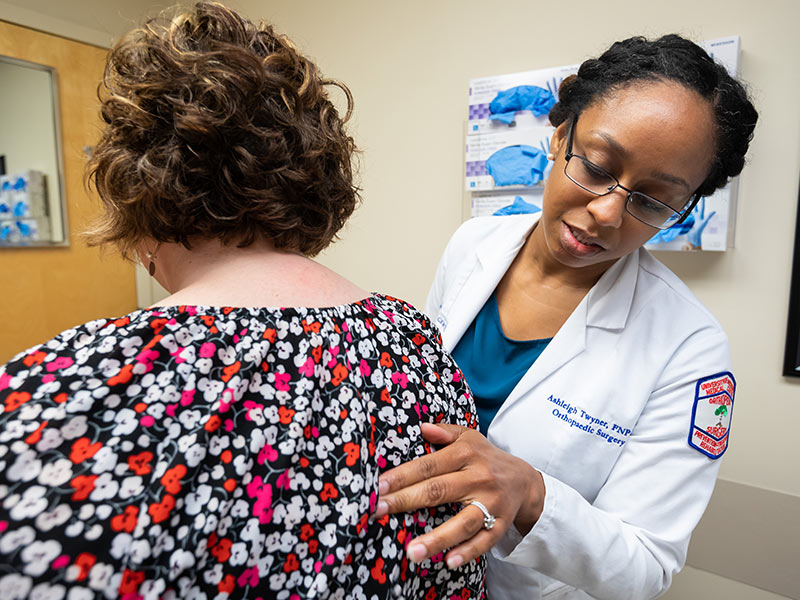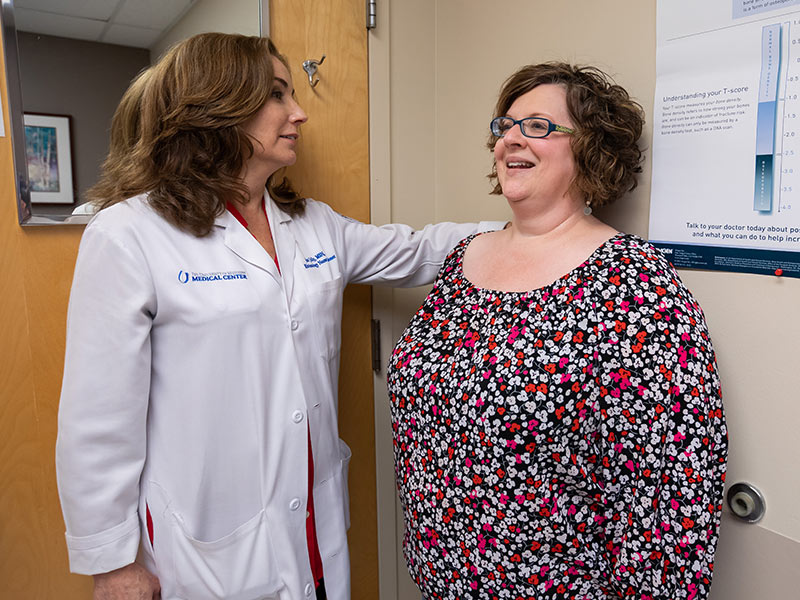New fracture clinic helps patients avoid one break leading to another

You’re a post-menopausal woman, and you take a simple tumble or bump into the corner of a table, something you’ve done more than once when you were younger.
But this time, you break a hip. That’s when some women find out they have osteoporosis, a weakening of the bones that increases their risk of a fracture. It happens when the body, as it ages, loses too much bone, makes too little bone, or both.
A new clinic at the University of Mississippi Medical Center is helping post-menopausal women who’ve broken a bone manage their health to avoid osteoporosis symptoms, and if they already have them, to take action to lessen their future risk of fractures. Women and men of all ages who have suffered a fracture due to osteoporosis also are treated.
“We’ve not done a very good job in this state of managing our osteoporotic population,” said Dr. Bob McGuire, professor of orthopedic surgery. “We are only treating about 20 percent of the people that we need to be treating, and patients often don’t follow up with the treatment regimen they’re given.”

The Secondary Fracture Clinic, located in Suite I in the University Physicians Pavilion, targets post-menopausal women who have recently broken a bone due to osteoporosis, in addition to risk factors that could lead to them developing it. It’s open the first Tuesday afternoon of the month and staffed by McGuire and the caregiver team of nurse practitioners Janet Jolly and Ashleigh Twyner and medical administrator Olivia Morris.
McGuire said the clinic is operated in collaboration with UMMC’s Division of Rheumatology and Molecular Immunology because that division takes in the diagnosis and treatment of diseases affecting the joints and treatment of connective tissue and autoimmune diseases. Some of those conditions require tests for bone density, also a prime diagnostic tool for osteoporosis.
About 54 million Americans have osteoporosis and low bone mass, and studies show that about one in two women and up to one in four men age 50 or older will break a bone due to osteoporosis, says the National Osteoporosis Foundation.
The biggest causes of osteoporosis are aging and the onset of menopause. Both can cause people to lose bone, breaking it down faster than the body is able to replace it. When that happens, bones can become less dense and more fragile – meaning even routine activities including walking, bending and lifting could result in an unexpected break.
And, it can be worse than a broken bone. Higher morbidity, loss of quality of life, chronic pain and disability are prevalent in those whose fractures are related to osteoporosis.
“We’re trying to close that gap where people have a fracture, go home, and when they begin feeling better they don’t think anything else about it,” Jolly said. “We need to make sure we are doing everything we can to prevent future fractures. When (people with osteoporosis) have one, the chance of another in the future is enormous.”
During a clinic visit, women receive a physical exam that focuses on their bone health. They may be tested for osteoporosis through bone densitometry, which uses X-rays to measure the density of bones that include those in commonly broken wrists, hips and spine. Testing also can include blood and urine checks for conditions that can cause bone loss.
The clinic also puts together a thyroid and metabolic profile on the patient. “If they’ve had a CT scan as part of the treatment of their fracture, we look at that. It gives us a pretty good idea of the quality and quantity of their bones,” McGuire said. “That gives us a ground zero.”
Clinton resident Amy Kittrell recently visited the clinic for the first time. Kittrell suffered a compression fracture of her spine earlier in the year when she fell from her deck after a snowfall. After receiving a bone density test in UMMC’s rheumatology clinic, she was asked if she’d like to visit the Secondary Fracture Clinic across the hall in the Pavilion.
“It makes sense,” Kittrell said. “You might have fractured your back, but your problem is probably in rheumatology.”

Patients are educated on lifestyle changes and medications that can arrest the breakdown of more bone, Jolly said. “We talk about common-sense safety measures and prevention,” she said. “We talk about proper diet, calcium and vitamin D-3 intake, and we stress the importance of exercise.”
Many people with osteoporosis have no idea that smoking and alcohol contribute to it. “We try to keep it at less than three alcoholic drinks a day. After that, you put yourself at risk,” Jolly said.
“We also focus on simple balance issues. If you have that, you need to use your cane or walker. You need to have clear pathways and no rugs. And, it’s preferred that you get your calcium and vitamin D through a healthy diet that includes yogurt, cheese and milk. If you can’t do that, then take a supplement.”
Kittrell said she’s addressing her low vitamin D level. “I’m anxious to get a plan in place,” she said. Her rheumatology and orthopedic caregivers working together, Kittrell said, “is a good partnership.”
Injectable medications are available to help prevent future loss of bone mass, Jolly said. Some are taken daily, some every six months, and others once a year. They include bisphosphonates, a class of drugs that prevents the loss of bone density, and abaloparatide, a hormone-related protein analog drug that’s a bone-growing agent.
“We want to be proactive on the education process,” McGuire said. “We want to educate at the grassroots level. And, we need our primary care providers to be more active. When they see patients, they need to say, ‘Let’s get a vitamin D level and a calcium level to see where you are.’”
It’s important to remember it’s not just women at risk of osteoporosis, McGuire and Jolly stress. Men have more bone mass than women, but as they age, it breaks down. “We do sometimes forget about the men,” Jolly said. “We’re trying to develop a culture in primary care to have this discussion with men, too, especially if they use steroids for other diseases. If you are a steroid user, you must have a conversation with your primary care doctor about your bones.”
Our grandparents taught us ways to prevent osteoporosis, Jolly said. Remember being ordered to “drink your milk?”
“With our aging population, osteoporosis is a given,” Jolly said. “The goal is to prevent future broken bones.”


